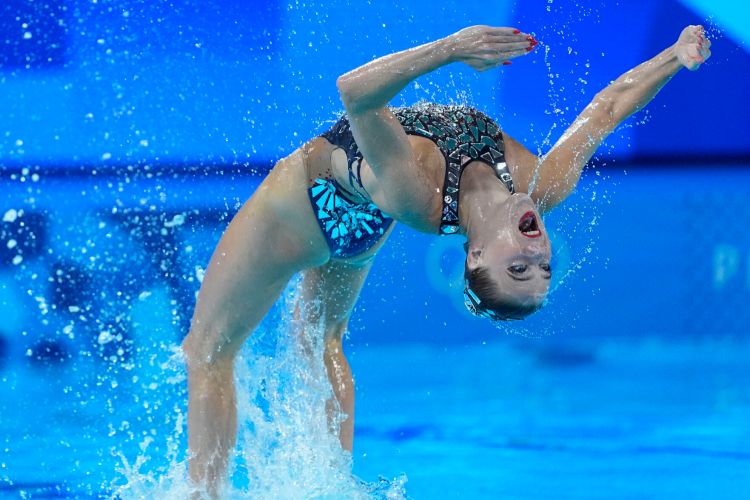What is artistic swimming? It’s a captivating blend of dance, gymnastics, and swimming, where athletes perform graceful and intricate routines in the water. This captivating sport demands artistry, athleticism, and an unwavering determination. Let’s dive into the depths of artistic swimming, exploring its history, techniques, and the captivating world it offers.
In artistic swimming, athletes showcase their skills in solo, duet, or team performances. They glide through the water with elegance, executing synchronized movements and breathtaking lifts. The sport’s origins can be traced back to the 19th century, where it was known as synchronized swimming.
Today, it’s recognized as artistic swimming, emphasizing the artistic expression and choreography that sets it apart.
What is Artistic Swimming?
Artistic swimming, formerly known as synchronized swimming, is a hybrid sport that combines elements of swimming, dance, and gymnastics. It involves synchronized and choreographed movements performed in water by a group of swimmers.
The sport has a rich history, evolving from water ballet in the early 1900s to its current form as artistic swimming.
Definition and History of Artistic Swimming
Artistic swimming is a demanding sport that requires a combination of athleticism, artistry, and teamwork. It is performed in a swimming pool and involves a series of synchronized movements, lifts, and throws.
The origins of artistic swimming can be traced back to the late 19th century when water ballet performances were popular in Europe. In the early 20th century, synchronized swimming emerged as a competitive sport, and the first international competition was held in 1933.
Over the years, the sport has undergone several name changes, including “water ballet,” “synchronized swimming,” and finally, “artistic swimming,” which was adopted by the International Swimming Federation (FINA) in 2017.
Basic Elements and Techniques
Artistic swimming involves a wide range of basic elements and techniques, including:
- Floating: Maintaining a stable position on the water’s surface without movement.
- Sculling: Using hand and arm movements to propel the body through the water.
- Body positions: Holding specific body positions, such as vertical, horizontal, or upside down.
- Strokes: Using different swimming strokes, such as the front crawl, backstroke, or breaststroke.
- Kicks: Using different kicking techniques, such as the flutter kick, scissor kick, or whip kick.
Competitive Structure and Scoring
Artistic swimming competitions are divided into different levels and categories, including solo, duet, team, and mixed duet.
Performances are scored by a panel of judges based on technical execution, artistic impression, and overall difficulty. Technical execution includes factors such as synchronization, precision, and body control, while artistic impression includes factors such as choreography, creativity, and musical interpretation.
Artistic and Technical Aspects

Artistic swimming is a highly artistic sport that places a strong emphasis on choreography, music, and costume.
Choreography plays a crucial role in artistic swimming, with swimmers creating complex routines that incorporate elements of dance and gymnastics. Music is also an important aspect of the sport, with swimmers performing to a variety of musical genres, from classical to contemporary.
Costumes are an integral part of artistic swimming, with swimmers wearing elaborate and colorful suits that enhance their performance and create a visual spectacle.
Physical and Mental Demands
Artistic swimming is a physically and mentally demanding sport that requires a high level of fitness and coordination.
Physically, artistic swimmers must have strong swimming skills, flexibility, and endurance. They must also be able to hold their breath for extended periods of time.
Mentally, artistic swimmers must be able to focus and concentrate for long periods of time. They must also be able to work well with others and follow instructions.
Health Benefits and Risks, What is artistic swimming
Artistic swimming offers a number of health benefits, including improved cardiovascular health, flexibility, and muscle strength.
However, the sport also carries some risks, including injuries to the muscles, joints, and spine. It is important for artistic swimmers to warm up properly before each practice and competition and to listen to their bodies and take breaks when needed.
Related Sports and Disciplines

Artistic swimming is related to a number of other sports and disciplines, including:
- Swimming: Artistic swimming shares many of the same basic elements and techniques as swimming.
- Diving: Artistic swimmers often perform dives as part of their routines.
- Gymnastics: Artistic swimmers use many of the same body positions and movements as gymnasts.
- Dance: Artistic swimming incorporates many elements of dance, such as choreography and musical interpretation.
Future of Artistic Swimming

Artistic swimming is a growing sport that is becoming increasingly popular around the world.
The future of artistic swimming looks bright, with new innovations and developments emerging all the time. One of the most exciting recent developments is the introduction of mixed duets, which allow male and female swimmers to compete together.
Artistic swimming is a challenging and rewarding sport that offers a unique combination of athleticism, artistry, and teamwork. With its growing popularity and promising future, artistic swimming is sure to continue to captivate audiences for years to come.
Closing Summary
Artistic swimming is a testament to the human body’s grace, strength, and artistry. It’s a sport that demands dedication, passion, and a relentless pursuit of perfection. Whether you’re a seasoned athlete or a curious spectator, the allure of artistic swimming is undeniable.
As the sport continues to evolve, we can expect to witness even more captivating performances and innovations that will leave us in awe.
Top FAQs
Is artistic swimming an Olympic sport?
Yes, artistic swimming has been an Olympic sport since 1984.
What is the difference between artistic swimming and synchronized swimming?
In 2017, the sport’s name was changed from synchronized swimming to artistic swimming to better reflect its artistic and expressive nature.
What are the basic elements of artistic swimming?
The basic elements of artistic swimming include floating, sculling, body positions, strokes, and kicks.
What is the scoring system in artistic swimming?
Artistic swimming is judged based on technical execution, artistic impression, and difficulty of the routine.